The Columbia River is the biggest river in the American West. It also comes up huge with fishing opportunities.
There are so many kinds of fish that anglers chase here.
The quarry includes native species like the largest run of king salmon (Chinook) in the lower 48, coho runs that can run so thick in boom years that limits come easily, and the largest of all freshwater fish in North America, the white sturgeon, which can grow to more than a dozen feet long, weigh over 1,000 pounds and fight like a freight train.
Today the river also is home to many introduced fish species, including walleye so big they may one day topple the world record, smallmouth bass so numerous and chunky and aggressive that the river is nationally ranked, and American shad runs so thick they clog hydroelectric dam fish ladders by the millions.
The river’s headwaters are in the Canadian Rockies and its longest tributary, the Snake River, originates clear over in Yellowstone Park in Wyoming.
The U.S. reaches of the mainstem Columbia plunge south through the heart of Washington state and then turn west toward the Pacific Ocean, forming much of the boundary between Washington and Oregon.
Along the way it tumbles out of towering mountains, rumbles through arid high deserts, courses through verdant farmlands and barrels to the ocean between coastal rainforests.
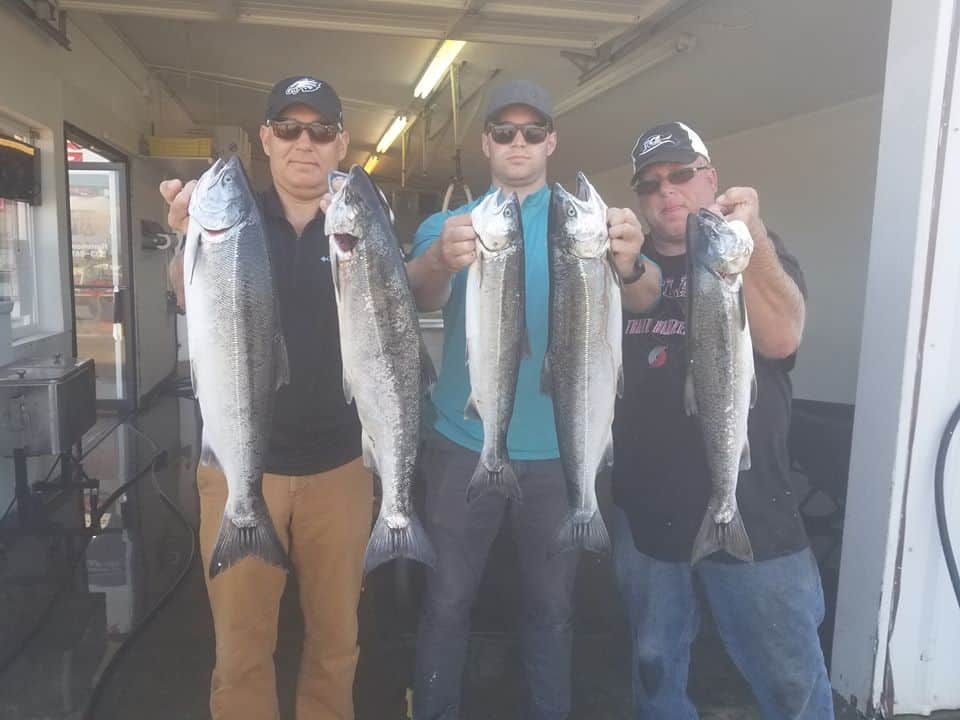
Through much of that length, there are massive hydroelectric power-generating dams that slow the mighty river into a series of pools.
Several sections, notably the Hanford Reach in central Washington and the 100 miles from Bonneville Dam to the sea, still flow free.
The changing river and varying climates provide a variety of habitats for the Columbia’s large numbers and many varieties of game fish.
This article is intended as a quick look at some of the most popular fishing options in this great river, meant to get you started on your fishing adventures.
Where we have additional information on the website, you’ll find links where you can get more details.
We also should note that both Washington and Oregon have issued advisories recommending that anglers limit or in some cases avoid eating certain fish caught in some waterways, which includes significant sections of the Columbia River.
The advisories mostly focus on naturally occurring mercury and human-caused PCBs that build up in fish flesh.
Generally speaking, migratory fish such as salmon, steelhead and shad are safe choices to eat, while full-time resident fish such as bass and sturgeon tend to build up more toxins in their meat.
If you plan to eat what you catch, review the following Washington advisories and Oregon advisories.
Native Game Fish in the Columbia River
The following fish species lived within the Columbia River system before new types of fish were intentionally or accidentally introduced.
Columbia River Chinook Salmon
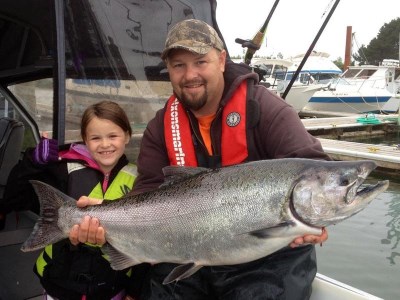
Chinook salmon return to the Columbia River in three runs: Spring, Summer and Fall.
Columbia River Spring Chinook Fishing
“Springers” are among the most prized of salmon. Even though they run on average smaller than summer and fall runs, these Chinook are among the tastiest anywhere, often said to rival the famous Copper River runs in Alaska for flavor.
Spring Chinook start returning in the late winter, but typically the fishable numbers from March through June on the lower river.
However, regulators in Oregon and Washington set seasons based on run forecasts and often close sport fishing during the height of the season if runs can’t sustain continued fishing. So it’s a must to keep track of changing regulations before fishing.
Spring Chinook tend to be caught more in the river itself, so the Buoy 10 area isn’t hopping during this time of year like it will be in late summer.
Where to Catch Columbia River Spring Chinook
There are popular springer fishing spots around Longview/Rainier, Portland/Vancouver and below Bonneville Dam.
Upriver, spring Chinook catches aren’t as large, but these fish are often intercepted at the mouths of tributary rivers.
For some more information, read: Portland Area Spring Chinook Fishing and check out one guide’s fishing tips from a nearby fishery in Lower Willamette River Spring Chinook Fishing Tips.
Columbia River Summer Chinook Fishing
Some of the river’s largest Chinook come in between the most populous spring and fall runs.
These summer-run salmon, often called “June Hogs” for their arrival time and jumbo size, don’t necessarily run as large as they did in the old pre-hydroelectric dam days, and they can be hard to come by, but they’re still big and wonderful to catch.
They often are fished in similar areas and with similar techniques as spring Chinook. Again, fish managers will curtail fishing if the runs aren’t sufficient to sustain a harvest.
Columbia River Fall Chinook Fishing
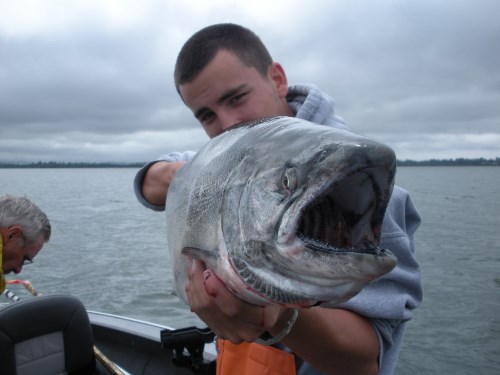
While called a fall run, the Columbia River’s largest run of Chinook typically arrives in August and September on the lower river.
August is when the Buoy 10 fishery near Astoria, Oregon, and Ilwaco, Washington, takes off with a blast. This is a busy place at this time, with potentially hundreds of thousands of both Chinook and coho salmon returning to the river’s estuary, where they are often willing biters.
August is usually the top month by far for catches in the estuary and also great in the river below Longview.
By September, the fishing around Portland and below and above the dams has taken off and many anglers move upriver with them.
Fall Chinook fishing is also good at the mouths of many tributaries and in the mainstem well into central Washington, including around the free-flowing Hanford Reach.
We have an essential guide to different methods to catch all salmon here. And we also suggest you read Buzz Ramsey’s Buoy 10 Salmon Fishing Basics and Buoy 10 Expert Tips: Trolling with Herring.
Columbia River Coho Salmon
The coho salmon run overlaps with the fall Chinook run on the Columbia River.
Where to Catch Columbia River Coho Salmon
Usually the fall Chinook show up first in fishable numbers in early August, but by the second half of August there often are good numbers of coho in the estuary’s Buoy 10 management area, which includes the areas off Astoria and Hammond on the Oregon side and Ilwaco and Chinook on the Washington side.
While many of the Chinook tend to run upriver by September, or regulations require release, taking many anglers upriver with them, the coho fishing in the estuary often remains quite good through September before fall rains draw them upriver.
September has the added bonus of being less busy than August in the port towns.
Once in freshwater, coho tend to bite less readily than they did with salt in their gills, but modest numbers of coho are caught upriver, including at tributary mouths.
More resources: Salmon Fishing: Simple Techniques and Tips, Buzz Ramsey’s Buoy 10 Salmon Fishing Basics and Buoy 10 Expert Tips: Trolling with Herring.
For freshwater coho fishing, read: Best Coho Salmon Fishing Near Portland.
Columbia River Sockeye Salmon Fishing
Sockeye are the smallest of the Pacific salmon that run into the Columbia River.
In the lower river, these fish tend to take a backseat to salmon and steelhead fishing, but they are often caught incidentally by steelhead anglers because the runs are similarly timed and the fish use similar parts of the river to swim upriver.
This has changed a bit with more anglers targeting sockeye when there have been some excellent runs in some fairly recent years, compared to long years of relatively few sockeye in previous decades.
Upriver in the Brewster area of Washington, sockeye are a popular game fish and are caught in great numbers when the runs are excellent.
Columbia River Chum Salmon
These greenish-hued salmon come into the Columbia River in modest numbers and spawn in low-gradient tributary streams in the lower Columbia River and in the main river below Bonneville Dam.
Chum are the focus of restoration efforts and are not a sport-fishing prize here.
Besides, they are the least tasty of the Pacific salmon potentially caught in the big river.
(Although chum are unbelievably strong fighters, so if you really want to try this, check out Washington state’s Hood Canal area to get one on the line.)
Columbia River Steelhead Fishing
These big ocean-going rainbow trout arrive in two major runs but are present in the river pretty much all year long to varying degrees.
Columbia River Summer Steelhead
“Summers,” as they are often called, arrive during a long period of spring and summer. They are headed upriver to natural spawning grounds and artificial hatcheries across Oregon, Washington and Idaho.
They are commonly caught by beach anglers because they swim relatively close to shore in fairly shallow water (roughly 6-12 feet depths), but boaters anchoring in the steelhead travel lanes can do particularly well.
While these are difficult fish to catch, especially with any kind of reliability, this is a really pleasant time to be on the bank or boat.
Where to Catch Columbia River Summer Steelhead
Look for catches to get going on the lower river in May and June.
Into the Portland area and up toward Bonneville Dam, fishing is often best in June and July, even into August.
East of the Cascades and on up into Washington state, the fishing for summer steelhead tends to be best when the water cools in the fall months.
Also read: Summer Steelhead Fishing Near Portland.
Columbia River Winter Steelhead Fishing
While these fish migrate up the Columbia in fair numbers, they aren’t targeted much. In fact, the modest catches in late winter and early spring are largely incidental catches while anglers target spring Chinook.
Winter steelhead are popularly fished in tributary rivers of the lower Columbia River, including the Cowlitz River in Washington and the Sandy River in Oregon.
Learn all of the best ways to catch these fish in Steelhead Fishing: Simple Techniques and Tips.
You might also be interested in Winter Steelhead Fishing Near Portland.
Columbia River Trout Fishing
Most of the Columbia River in Washington and Oregon runs too warm in the summertime to sustain great trout fishing.
However, there are some big native and planted rainbow trout (and the rarer bull trout) in the river’s huge reservoirs, especially in Rufus Woods Lake and Lake Roosevelt to the Canadian border.
Farther downriver, it’s much better for trout anglers to veer up one of the Columbia River’s great trout-fishing tributaries, perhaps the lower Deschutes River in Oregon or the upper Yakima River in Washington.
To learn more about catching these fish, take a quick read through our simple guide to trout fishing.
Columbia River Sturgeon Fishing
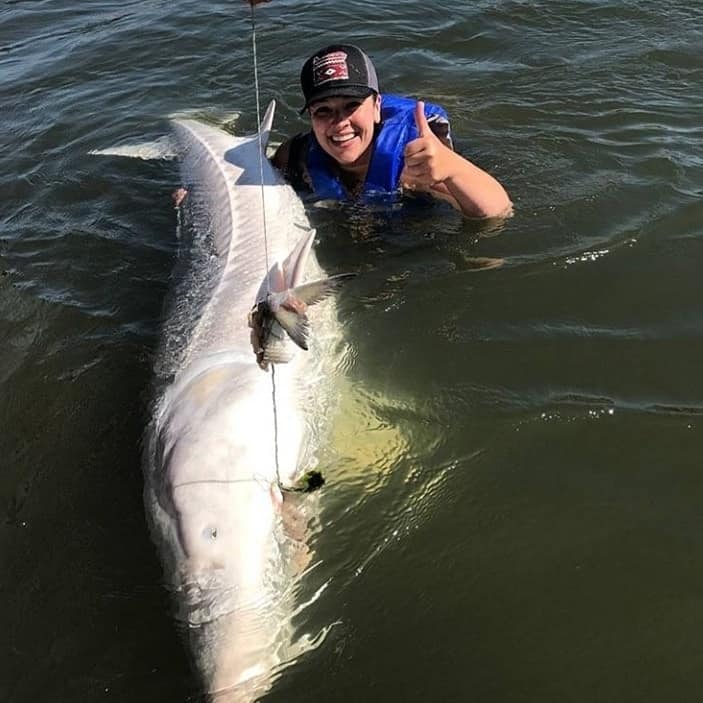
When you first spot one of these giants rising from the depths on the end of your line, you might think: Great White Shark!
Then you notice that instead of a mouth full of teeth, the sturgeon has a round, rubbery mouth used to suck up food like shrimp, clams and injured fish from the river.
Much of the Columbia is home to the biggest sturgeon around, the white sturgeon.
The fish below Bonneville Dam travel in and out of the Pacific Ocean, often trekking to coastal bays to feed on shellfish and then back to the Columbia to feast on shad, smelt, salmon and other forage, and to spawn below Bonneville Dam or in the Willamette River.
The lower river currently is regulated as catch and release, except that the states have allowed some limited retention periods in recent years. Watch for state fish and wildlife agency announcements for short windows when retention is allowed.
White sturgeon also inhabit some of the upriver pools and Hanford Reach in central and eastern Washington and Oregon, with some modest harvest opportunities in places.
There is a growing hatchery-based sturgeon fishery with the opportunity to keep a good-sized fish in the Columbia in the Tri-Cities and Yakima areas.
Of course, check the regulations before fishing. And read more here: Columbia River Sturgeon Fishing as well as getting all the tips and techniques with Sturgeon Fishing on the West Coast.
Columbia River Northern Pikeminnow Fishing
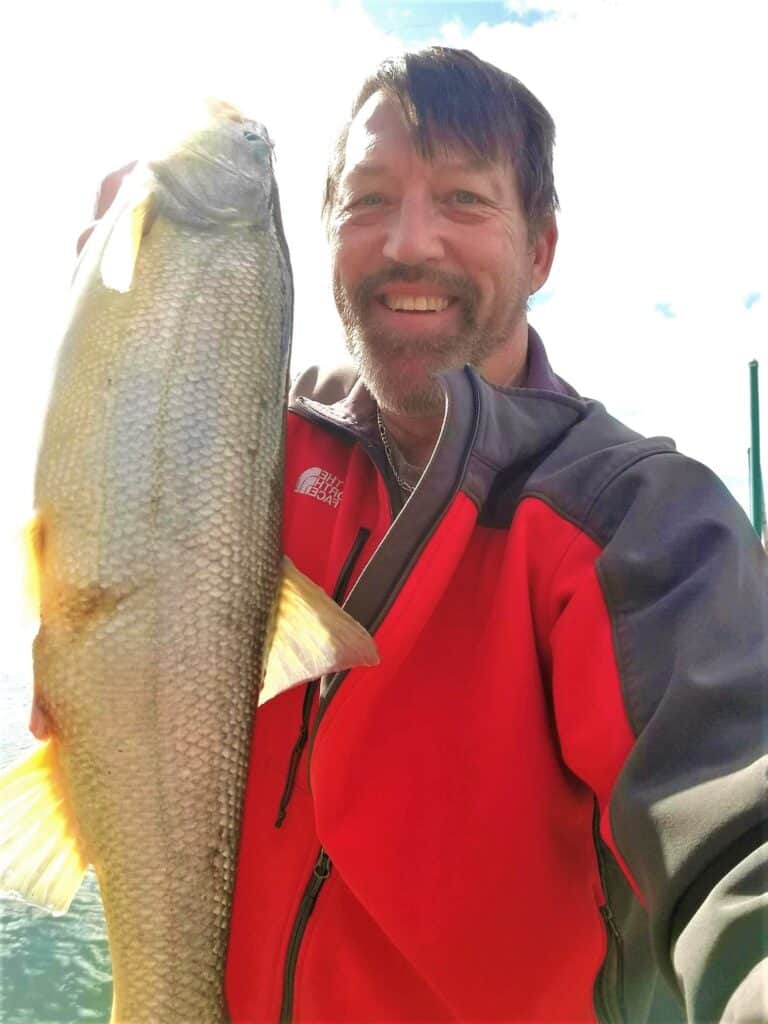
Some of you will blanch to see this fish on a list of game species.
Northern Pikeminnows aren’t exactly known as great sport fish or good table fare. However, they can be fun and easy to catch where you find them.
Get Paid to Catch Fish
But, honestly, here’s the real rub: You can trade in these fish for cash! That’s right, the Bonneville Power Administration funds a sport-reward program (some people call it a bounty) that pays anglers who catch these fish in the Columbia and turn them in at designated stations.
The reason for the reward fishery is that pikeminnows eat a tremendous number of baby salmon and steelhead trying to migrate downriver.
Since the BPA manages the dams, and the dams have slowed smolt migration and made it easier for pikeminnows to much the small fish, the sport-reward program is meant to help rebalance the odds to aid salmon and steelhead, including several protected runs.
Pikeminnows are a native species but have become over-populated in the reservoir-filled river.
Where and How to Catch Pikeminnows in the Columbia
They can be caught throughout the river system, but are commonly found below dams and in spots where they can lay just outside of the strong current and dart out to eat smaller fish.
Bait and lure techniques will catch them. Some anglers learn to catch enough pikeminnows to earn thousands of dollars in a season.
(By the way, this fish used to be known as a squawfish but the official name was changed in the late 1990s because the former name was offensive.)
To learn more about the sport-reward program, look here.
Non-native Game Fish in the Columbia River
These species were directly or indirectly introduced to the Columbia River, primarily from central and eastern U.S. waters.
Columbia River Smallmouth Bass Fishing
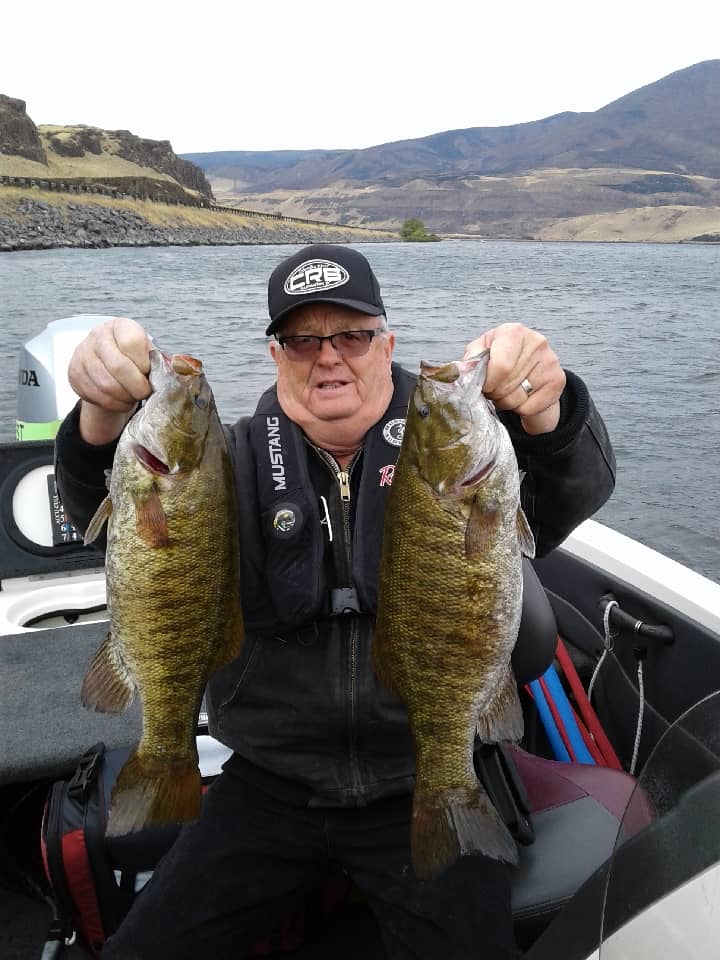
The Columbia River is a smallmouth bass factory.
Its varying currents, rocky habitats, and plentiful food sources are tailor-made for this river-loving bass.
Fishing for smallies can often be excellent from the Portland-Vancouver area way up into north-central Washington, in both free-flowing river sections and in the reservoirs.
Many tournaments are held in the river each year, including some big national events, and 5-pound smallmouth are relatively common.
Where to Catch Columbia River Smallmouth
The hardest part may be just deciding where to fish, because the river is huge and the options almost endless.
Look for rocky shorelines, islands, sunken rock piles and humps, and you’re in business. Artificial structures such as riprap and pilings are just as good.
Soft plastic lures, crankbaits, spinnerbaits, and other lures that imitate favorite prey such as crayfish and minnows will get the job done with these aggressive biters and fighters.
To learn more about catching smallmouths and other bass, be sure to take a few minutes to read our Bass Fishing: Simple Techniques and Tips.
You also will want to check out Best Smallmouth Bass Fishing in Washington, Best Smallmouth Bass Fishing in Western Oregon and Best Smallmouth Bass Fishing in Central and Eastern Oregon.
Columbia River Largemouth Bass Fishing
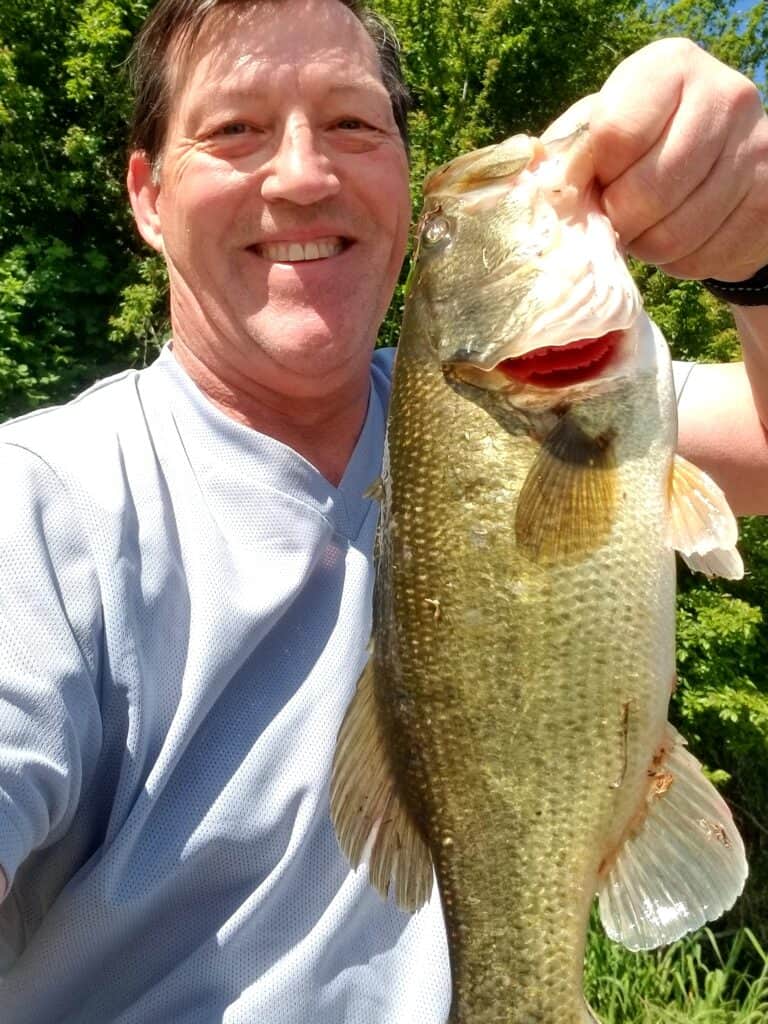
These are a bigger individual fish but a smaller overall presence compared to smallmouth in the Columbia River.
While largemouth were once more dominant in some areas, smallmouth are better suited to much of the river’s habitat and have taken the majority of it over.
Where to Catch Columbia River Largemouth Bass
However, largemouth bass are still a force in parts of the river, especially in backwater coves and sloughs with softer bottoms and where aquatic vegetation, fallen trees, docks and similar structures dominate the habitat.
There are a number of good backwater fishing spots for largemouth on the lower Columbia River and connecting waterways, but these big bass also are available upriver.
Try similar but often bigger lures for largemouth as for smallmouth. Surface lures can be a blast on a warm evening.
Read: Largemouth Bass Fishing in Western Oregon.
Columbia River Crappie Fishing
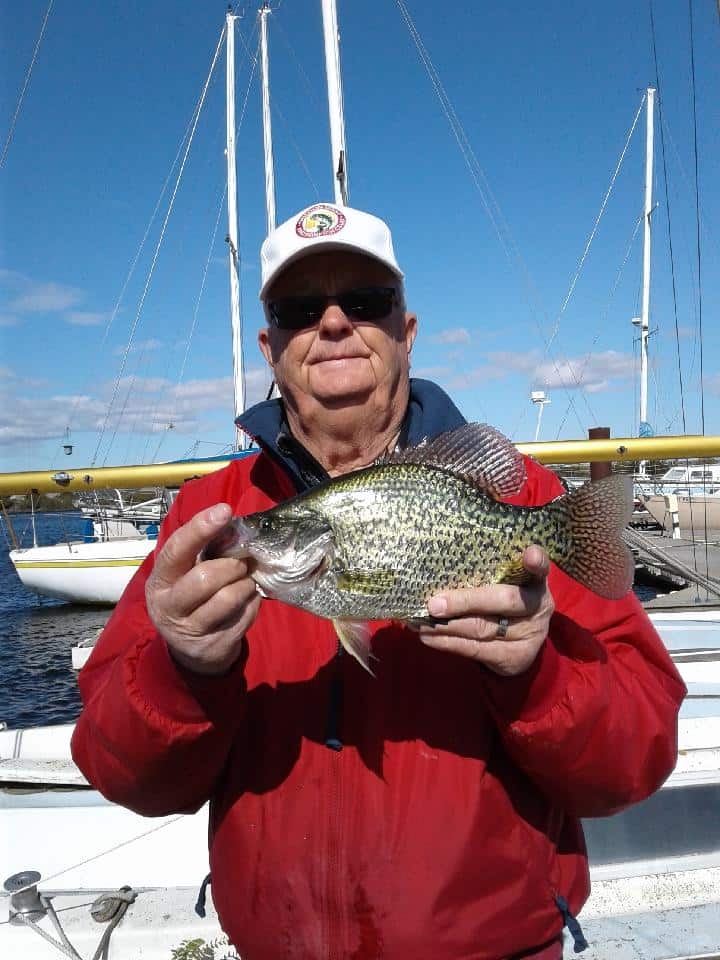
Crappie are a favorite with many warmwater anglers.
They are aggressive biters and although not always strong fighters, they put up a fun battle on light tackle.
Also importantly, they travel in schools and in some places can be caught in great numbers.
Where to Catch Columbia River Crappie
In the lower Columbia River, they are often in backwater areas, moorages and some of those little ponds and pits along the highways connected to the main river.
Farther up, try areas out of the current, including a very nice fishery in the McNary Pool. (See crappie photo in this article for an example of a Boardman-area crappie.)
Crappie can often be found suspended around structure, such as sunken trees and docks and pilings.
A fish finder might come in handy, because not all holding areas are apparent from the surface.
Crappie love eating small fish, so lures including small jigs that imitate minnows are ideal.
If you’d like to learn more about catching crappie, read our simple crappie fishing guide to the best tips and techniques.
Some other articles to get you into slab crappies in the region include: Crappie Fishing in Western Oregon and Crappie Fishing in Central and Eastern Oregon.
Columbia River Walleye Fishing
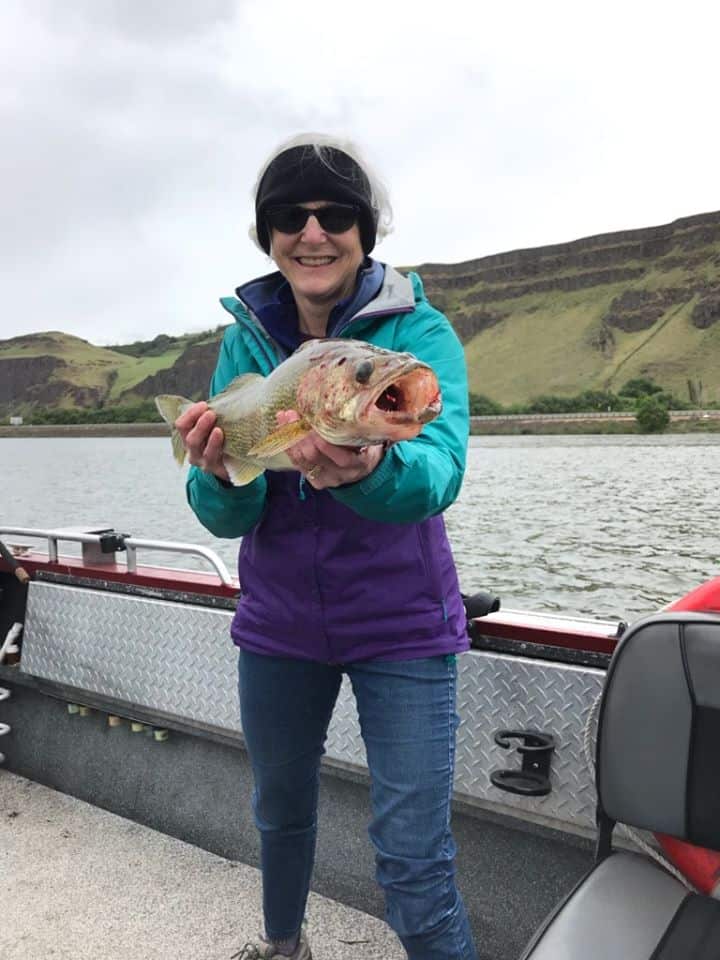
The Columbia River has become one of the best walleye fisheries around, certainly one of the best outside of the Midwest where these transplants are from.
Like smallmouth bass, walleye are caught in a long section of the Columbia, from below the Portland-Vancouver area well up into Washington.
Several of the reservoirs offer outstanding fishing.
Walleye aren’t as easy to catch as smallmouth, but anglers trolling nightcrawler rigs or lures, or using other techniques like jigging, eventually learn the best holding waters around ledges, sunken rock piles and other walleye haunts.
And for many anglers, walleye are one of the best-tasting of the white-fleshed fishes.
Learn more about the catching part with Walleye Fishing: Simple Techniques and Tips.
It would also be a good idea to read Walleye Fishing in The Dalles Pool for a famous walleye guide’s best tips for Columbia glass-eyes.
The Columbia River also features prominently in our run-down of the best walleye fishing spots in Washington state.
Columbia River Catfish Fishing
Catfish are quite common in parts of this big river.
Columbia River Channel Catfish
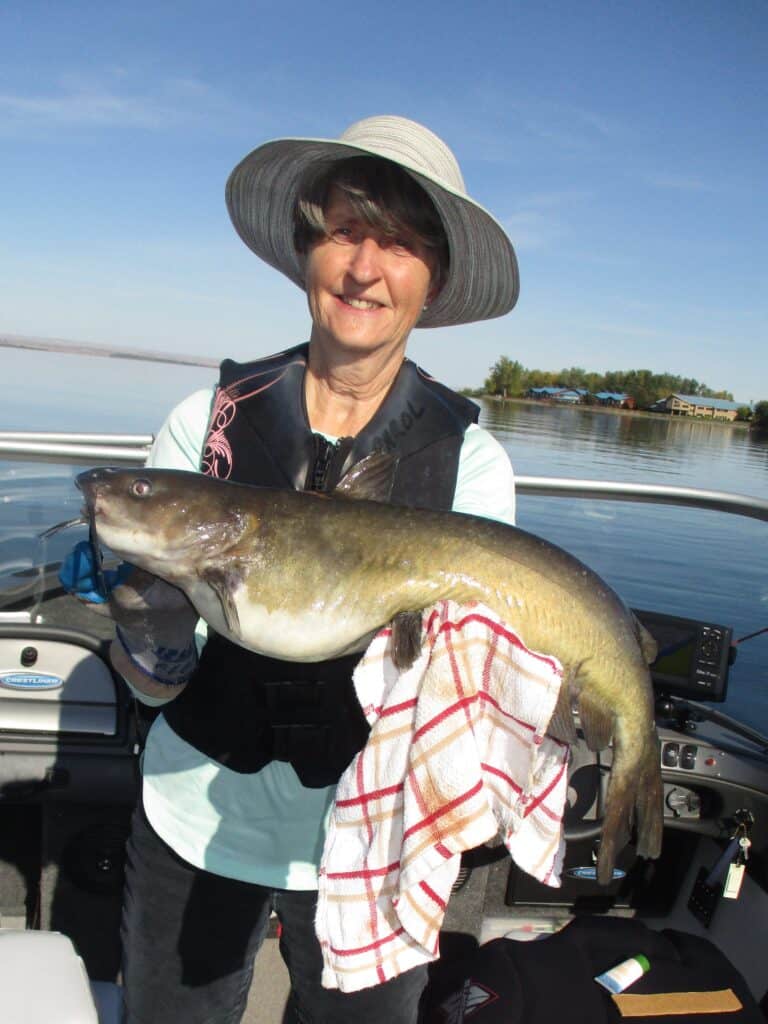
The favorite catfish in the Columbia River (and in many places across America) is the channel catfish.
Channel cats can grow to impressive size and can be caught in good numbers in some areas.
They also are very tasty and put up a good fight, even occasionally striking a bass or walleye lure.
However, bait fishing is most effective, with nightcrawlers, shrimp, cut fish and other natural baits as well as artificial prepared dough baits all good options.
Channel catfish are relatively scarce in the lower river, but become more numerous in the central parts of the river, such as the McNary Pool and mouth of the Snake River in Washington.
(Much of the Snake River itself and its reservoirs offer very good numbers of channel cats, and these fish also can be found in the lower sections of some tributaries, such as the Yakima River and Walla Walla River.)
Bullhead catfish are numerous in many parts of the river and can be easily caught on bait. They often run small and sometimes fill riverside ponds, where kids can have a blast.
To catch more of them, read our guide to simple catfish fishing techniques and tips.
Also find more great places to find them in Best Catfish Fishing in Oregon and Best Catfish Fishing in Washington.
Fishing for American Shad in the Columbia River
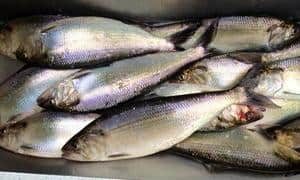
Shad are an East Coast native, the largest fish in the herring family.
They often weigh a few pounds apiece and are a silver frenzy on the end of your line once hooked.
When to Catch Columbia River Shad
These fish literally come up the Columbia River by the millions in the late spring and early summer.
Look for the counts at Bonneville Dam to begin to rise into the five and especially six digits per day and you’re in business.
Fishing usually gets worthwhile during the second half of May and peaks in June, with some reasonable success into early July as the run starts to taper off.
Where to Catch Columbia River Shad
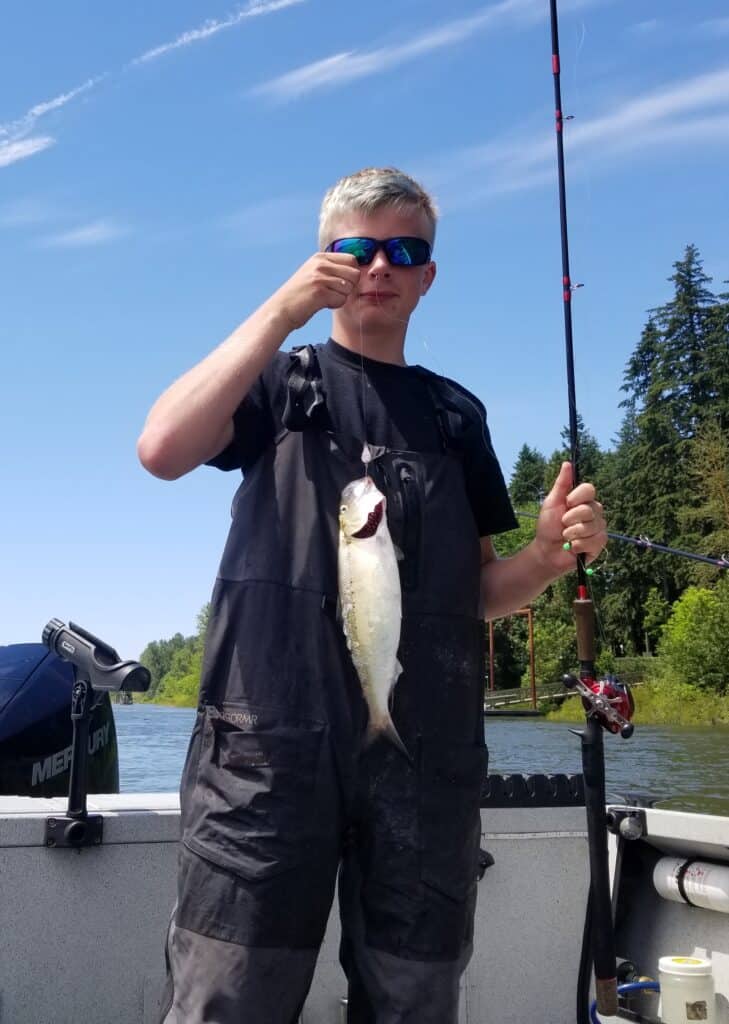
There is superb boat fishing for several miles below Bonneville. Just anchor (very carefully) in moderate current that’s not too deep, and you’re in business.
Bank angling also can be very good at several spots below the dam on both sides.
Shad fishing continues to be very good up through the next several dams, with the best fishing often found in the areas below the dams where the shad tend to congregate in massive numbers before climbing fish ladders.
Downstream from the John Day and McNary dams are great bets as well as below Bonneville.
Small spoons, jigs, soft lures, and even bare hooks are used. Bank anglers often use drift-fishing techniques.
Read more: Shad Fishing: Simple Techniques and Tips and Best Shad Fishing in Oregon and Washington.
More Columbia River Fish Species
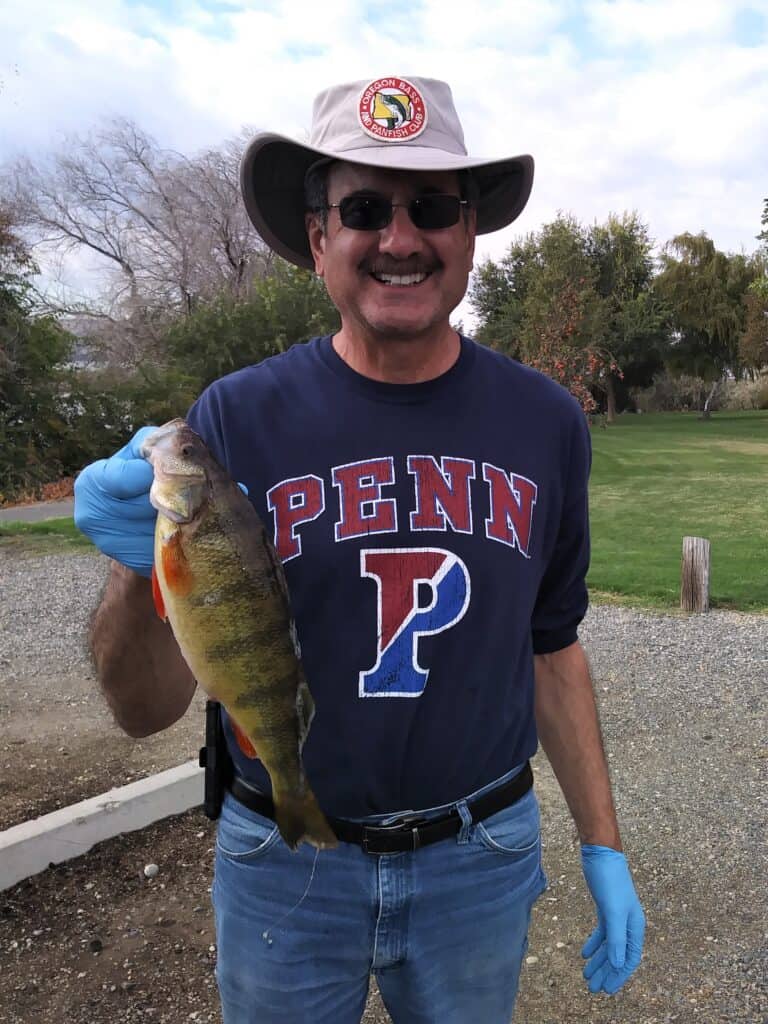
Among other fish species you are likely to catch (but generally of less interest to Columbia River anglers) include yellow perch, several types of sunfish (including bluegill and redear sunfish), suckers, carp, peamouth and others.
In the lower Columbia River, it’s possible to catch starry flounder that occasionally swim into freshwater.
On rare occasions, striped bass have made their way into the river, likely from rivers on the central and southern Oregon coast where these fish are more common.
And one day we might have to revise this article to include northern pike among species of larger interest, as these invasive species from the upper Midwest have spread into parts of the upper Columbia River system at least as far as Lake Roosevelt despite efforts to stop them.
Fisheries managers with the state and tribes fear these big predators eventually will impact the salmon and steelhead runs downriver.
See also:
Best Fishing in the Lower Columbia River
Best Fishing in the Mid-Columbia River
Oregon Resources
ODFW Weekly Fishing Report
ODFW Trout Stocking Schedule
Oregon Fishing Regulations
National Weather Service
Washington Resources
WDFW Fishing and Stocking Reports
WDFW Fishing Regulations
National Weather Service forecasts

